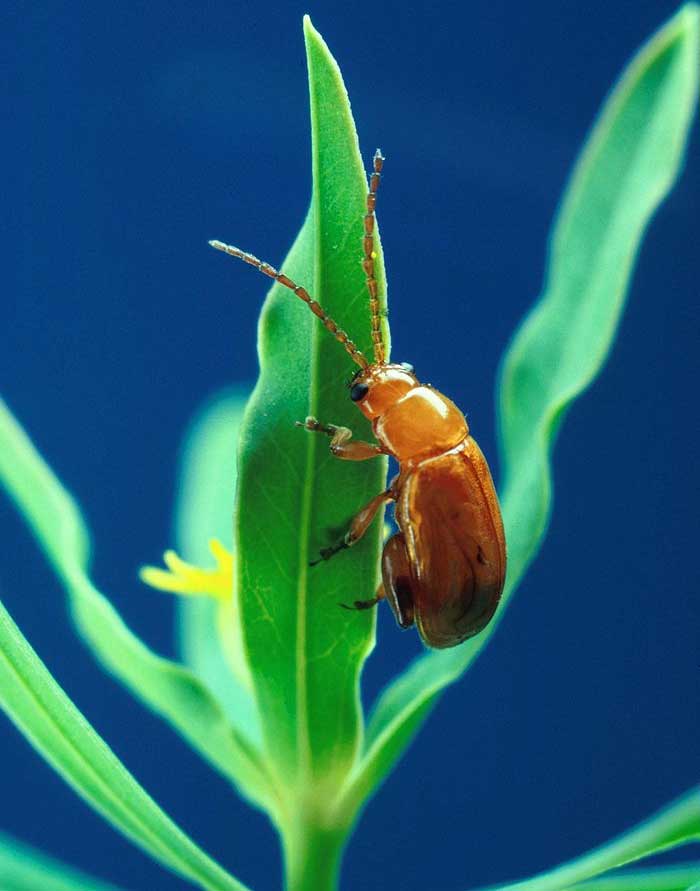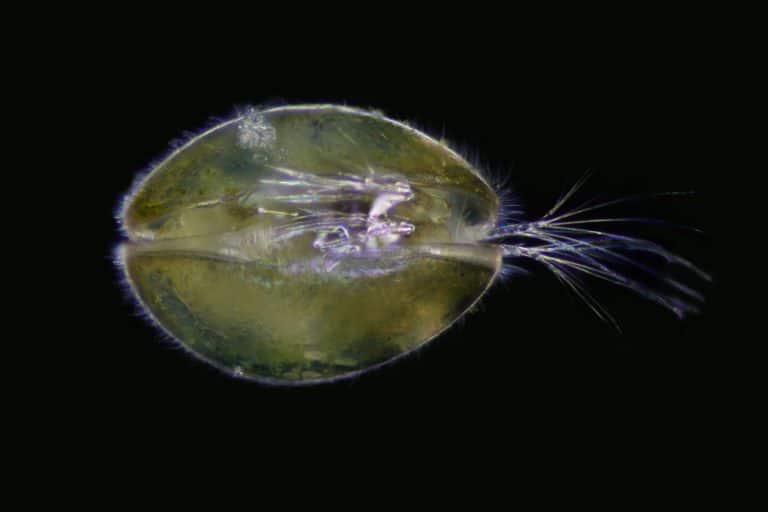Flea Beetles
Scientific Classification
| Kingdom: | Animalia (Animals) |
| Phylum: | Arthropoda (Arthropods) |
| Subphylum: | Hexapoda (Hexapods) |
| Class: | Insecta (Insects) |
| Order: | Coleoptera (Beetles) |
| Suborder: | Polyphaga (Water, Rove, Scarab, Long-horned, Leaf and Snout Beetles) |
| Superfamily: | Chrysomelidae (Long-horned and Leaf Beetles) |
| Family: | Chrysomelidae (Leaf Beetles) |
| Subfamily: | Galerucinae (Skeletonizing Leaf Beetles and Flea Beetles) |
| Tribe: | Alticini (Flea Beetles) |
Flea beetle is a commonly accepted title referring to the tiny, hopping beetles belonging to the leaf beetle family – Chrysomelidae. Their tribe, being Alticini, is a section of the subfamily – Galerucinae. All along the United States, you can see a variety category of Flea beetles. These tiny hopping aphids can be usually noticed in your cultivated plants and flowers. Externally, they are very much like Fleas. They may cause destruction to our nursery by chomping abundantly on the cavities in the leaves and creating an insatiable annoyance. These holes give the impression that those leaves have been speckled with bullets. If their numerical strength is immense, Flea beetles are able to remove the whole leaves and thus destroy the plant completely at high speed. They invade and eat a large collection of plants that may also contain edible fruits as well as seeds, tuber crops, leafy vegetables, etc.
Physical Structure
The posterior legs of the Flea beetles are bigger in size so that, whenever it is disturbed it can leap with its help. Fully grown up beetles will be short, about one tenth of an inch, and gleam in dark brown or black shades. A few of them have white or yellow lines on the elytra. Larvae of Flea beetles are also smaller and they are cream shaded, slender and soft bodied ones (1/8 – 1/3inch). They prefer to live beneath the earth and their favorite eatables are rhizomes, tuber crops and sprouting seedlings.
An anomaly to this is the one fourth inch longer Flea beetle, which varies in color from black, bronze, bluish or brown to metallic gray. Some groups have lines in addition.

Wheel of Life
Mature beetles become active in the spring and eat the anchoring plants as the fresh advancements occur in it. Till then, throughout the winter they spend their time in the dust or on the remains of the cultivated plants and flowers. They lay small white colored seed cells in the holes of the ground situated near the bottom of the plants. Within a single week, these eggs will brood and the delicate larvae come out of it. They eat the plant radicle (Transition, Word Origins and More Definitions-The part of a plant embryo that develops into the primary root) for around 2 – 3 weeks. Pupal stage is short, as they persist beneath the earth only for 7 – 9 days. By this time, they become fully grown and thus their course of development will be finished. It is estimated that, In each year, there will be 1 – 4 breedings, counting on the category and also the climatic conditions.
Fully grown up Flea beetles spend their time during the winter in debris and different kinds of shrubs. At the beginning of the spring season, they become energetic. The females deposit only one or a group of ovums in the tiny gaps beneath the soil, rhizomes or foliage of a variety of plants. They can be usually found in a cruciferous plant with four petals arranged in a cross, including radishes, broccoli, cabbage and turnips.
Providing Nourishment
As the Flea beetles are of different category and also are large in number, they can derive the benefit of diverse variety of edible materials that are accessible in their environment. A few are all–devouring, but the others, remarkably specific in their abstinence from food. Most of the beetles like, Leaf beetle, Longhorn beetle, and Weevils are capable of living on one category of hosts, and usually eat one type of plants. Ground beetles and Rove beetles belonging to the family of Staphylinidae are basically flesh–eating ones. They fasten and devour some of the arthropods and a few target slow moving earthworms and snails. The voracious beetles are competent in different fields whereas some groups have clear–cut prey preferences.
The basic diet for most of the categories is the rotting substances of nature. That may vary from the excrement of animals, as consumed by the beetles belonging to the family – Scarabaeidae, to the deceased beasts which are eaten by the beetle family – Silphidae.
Behavior
In the matter of finding out a mate, the chemicals produced and released by the Beatles play a vital role. While copulating, the beetles exhibit intensely complicated demeanor.
Various categories of beetles employ distinct compounds in the production of a smelling substance, which attracts the other beetles. In Scarab beetles like Rutelinae, it is an extraction from the amalgamation of fatty acids, whereas certain other Scarab beetles utilize the elements of amino acids as well as terpenoid (Wikipedia- large and diverse class of naturally occurring organic chemicals similar to terpenes, derived from five-carbon isoprene units assembled and modified in thousands of ways). The beetles in the family Coleoptera make use of the biochemical emission of light to detect their mates. This method, in which the illumination is emitted by the light – generating means in their midsection, is commonly adopted by the fireflies (Lampyridae).
The males and females may employ different patterns of actions ahead of copulation. They shake the objects on which they are sitting. Different forms of beetles mate in various ways, but the most important thing is that, they won”t cohabit if the formalities that they accomplish beforehand didn”t take place.
Reproduction
Flea beetles are included in the super order, Endopterygota, and subsequently they are subjected to entire transformation. There are four major phases in their development – the egg, the larva, the pupa, the fully grown beetle. Usually larvae are referred to as grubs and pupa as a chrysalis. In the final stages of the larval phase, they build a protective covering and the pupa will be placed within it. Sometimes they go outside the limits of entire transformation, as in the families, Meloidae and Ripiphoridae.
As an Annoyance
Flea beetles are a threat to the crop production, involving leafy vegetables, mustard and rapeseed. Flowering plants are also prey to their invasion. They become energetic on days which have sufficient sunlight and start their assault in horrid climate. The larvae are famous for chomping the plant bases.
Methods to Get Mastery over Them
Flea beetle attacks can be brought down effectively with the help of validated techniques utilizing natural resources.
Summary
We can see a variety of categories of beetles in the United States. Actually, they are tiny hopping aphids, which are very much alike, the fleas, and are usually seen in the plants that we grow at their developing stage. Being a greedy destroyer, they cause much destruction to our plants by nibbling the foliage and by making a number of cavities in it.
Fully grown up beetles are short, glittering ones with the shades of dark brown or black. Whenever irritated, they can hop from there using their back legs. A few may have white or yellow lines on their elytra. Larvae are tiny and spend their phase beneath the earth by eating the roots of plants.
The most important thing that we need to keep in mind is that the Flea beetles transfer many diseases caused by virus and bacteria.

Having discovered a fondness for insects while pursuing her degree in Biology, Randi Jones was quite bugged to know that people usually dismissed these little creatures as “creepy-crawlies”.







